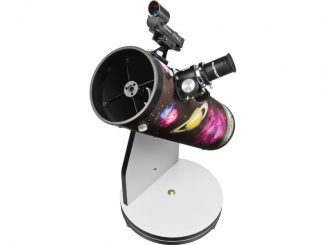
This is a fairly conventional truss-tubed Dobsonian, but fired with GOTO. It comes supplied with a 28mm ‘Deepview’ eyepiece plus a 12.5mm illuminated Plössl. The latter assists in setting up the red dot ‘EZ finder’ – although this could well do with a larger optical companion on this 305mm (twelve-inch) leviathan.
The ‘box’ section mount and the optical tube assembly (OTA) came delivered in three large boxes. It went together easily, probably taking about an hour. I was very impressed at how rigid the wood-based mount became when all of the locking threads were tightened. The same goes for the OTA; its two rolled steel cylinders (‘head’ and mirror assemblies) were locked in place by the truss poles as stiffly as a solid tube. Designed to be easily disassembled, it is portable and ‘small car’ friendly.

The primary mirror has a cover protection from the elements when not in use, yet the secondary mirror has no dust cap. I always find this common lapse totally bizarre, since its much smaller collecting area is (relatively speaking) far more valuable.
A visit to the Moon
The GOTO system is of the eminently respectable SynScan AZ type, with set-up modes affording auto-tracking and GOTO. On my first clear night, a short start-up session quizzed me on my co-ordinates and local time, after which I opted for the ‘two star’ align using Vega and Altair.
Deploying the supplied 28mm (54×) eyepiece, I set the telescope to find the waxing gibbous Moon, creeping its lazy way low across the southern meridian. Absurdly, GOTO systems often have difficulty finding the Moon, perhaps because of its rapid motion relative to the celestial sphere. Yet the Orion XX12g pinioned it squarely in the eyepiece’s approximately one-degree field at its first aim. Very impressive.
A gibbous Moon offers a deeply coruscated terminator full of craggy detail. Moving to the 12.5mm (150×) eyepiece, I drank from the inky elongated pools of the southern highland craters Schiller and Gassendi before using the SynScan hand controller to track north and gently sunward towards the Imbrium basin, settling finally on the crater Copernicus. Its floor and terraces were bathed by exquisitely angled sunlight and the observed resolution demanded a deep dive into the crater’s mouth.

Making full use of the GOTO and slew functions, there was but a purr from the alt-az motors, a welcome change from the brash rattle of some drive systems. One minor annoyance was the otherwise excellent Crayford-style focuser, whose large tactile focus knobs are so positioned as to leave insufficient room for fingers to pass between them and the main tube.
Clusters and ice giants
As further nights offered themselves, late autumn sessions gave prequel to winter’s familiar beacons. High in the east, the Pleiades offered a suitably starry field for the ‘Deepview’. Its 54× power showed many of its members, but the field of my own 56mm (27×) corralled them all. Transfixed against a very dark field, the lesser stars were so stunningly lifted out of the gloom by the telescope that the familiar ‘mini-dipper’ pattern of the major stars was almost lost.
Overhead, Perseus’ double cluster offered a twin splash of scattered stars that filled the view; importantly, there was no discernible degradation of star images from centre to edge, save perhaps for some little evidence of the coma expected of this focal ratio. My corrector lens easily brought these peripheral sluggards into line.
Autumn, however, brought a dearth of available planets with only distant Uranus and Neptune saving the sanity of planetary observers. The opposition of Uranus provided a unique opportunity for the XX12g to show its mettle, and so it did. Using a 10mm (150×) eyepiece, it provided a superb fulsome disc, a grey-green marble that seemed almost close enough to touch. Pushing my luck to a 5mm (300×) I had but a few moments of great seeing before our spinning Earth spun a tree between us. Thwarted, but undaunted, I progressed to Neptune. Although a fair stride eastwards, the motors gently ushered the tube to just the right place; impressive, despite my almost cursory placement of the Dobsonian on level ground. Having moments before observed its ‘twin’, the difference in appearance was stark. It revealed a relatively diminutive disc with its beautiful turquoise tint.
This is an optically fine telescope, companioned with a very robust mount. I thoroughly enjoyed using its very able GOTO system, which never failed. I shall remember this telescope most for two wonderful observations; gazing into the maw of Copernicus, and cleaving the double star components of epsilon Lyrae so cleanly that they looked like a small open cluster.
Orion SkyQuest XX12g Dobsonian
Aperture: 305mm (12 inch)
Focal length: 1,500mm
F-ratio: f/4.9
Focuser: Dual-speed two-inch Crayford (11:1)
Supplied eyepieces: 28mm (three-element) Deepview, 12.5mm illuminated reticle Plössl
Finder: EZ Finder II reflex (red spot)
Weight: Base 40kg (89 lbs), tube assembly 21kg (47 lbs)
GOTO system: SynScan AZ – 49,000 objects
Power requirements: 12V DC, 2.1 amp
Price: £2,199
Steve Ringwood is Astronomy Now’s Equipment Consultant.



